Part of a continuing series looking at the pagan origins of the Christmas Myths,1 one day at a time. Today, the reason we celebrate on December 25 …
As every child knows, Christmas falls on December 25th every year. Every year.
But is it because it says so in the Bible? Hell no!
The early Christian churches who did observe the Nativity2 celebrated it sometimes in May, sometimes in April, occasionally in January. So clearly they had no clue when legend had it their Saviour was born.
Nor did they know even which year he was supposed to have been born, the celebrated census causing the one-off visit to Bethlehem being a fabrication of census found nowhere else in the historical literature. So not a great way to start a calendar then.
The authors of both Matthew and Luke suggest these events happened in the days of Herod, the King of Judea.3 But this Herod died in 4BC. The authors of Luke talk too about a census “made when Cyrenius was governor of Syria” (one unknown both to historians like Tacitus and Josephus, and apparently to the authors of Matthew), just to have their boy born in the City of David. But while they get him to Bethlehem in order to please their Jewish readers, they face the problem that according to Josephus, the only historian to mention anything like this, Cyrenius didn’t become governor until either 6 or 10AD.
Quite a problem.4
Put beside that larger problem, the problem of the month, or day, seems almost minor. But you do have to wonder what sheep and shepherds were doing out in the fields at night in midwinter where snow occasionally “blankets the region.”
Now, despite the fact that not one of them had any clue, there is in fact a very good reason that fifth-century church fathers eventually settled on a date of December 25 to celebrate when their divine boy was born, and it wasn’t because of anything they’d put in their book.5 It was because folk had been out in the streets for thousands of years already on December 25 celebrating the birth of many other divine boys all born the same day.
And so, rather than fighting the ages-old tradition, the church fathers of what was now a state religion enforced by military arms figured with the full might of the Roman Empire behind them they could simply usurp the heathens6 by main force. Usurp them by adopting their rituals, banning their heresies, burning their books--and trying to bury the memory that they had ever existed.

Which is a nasty enough story, but it still doesn’t explain why December 25 was such a crowded calendar for divine birthdays. To a modern ear it might sound strange, but the simple explanation is that this day in December was the best day to celebrate one of the most important moments of every year: the winter solstice.
That’s why virtually every early culture in and out of Christendom celebrated it, from China to India, from Buddhist temples to Celtic dolmens, sometimes adding the legends of divine birth to allow their divinity to absorb the power of the moment.
It’s easy to forget this, living as we do in the two-hundred years out of all human history in which the industrial revolution has made it possible for billions to complain about #FirstWorldProblems, but in a pre-industrial society the annual harvest was everything—it was literally life or death.
And in pre-scientific stone-age societies, where all these myths and their rituals were born, it’s easy to forget the cause of the returning harvest was utterly unknown.
 It was the result, surmised most cultures, of battles between competing gods; between gods of light (“I am the light of the world,” said Attis, Mithra, Uncle Tom Krishna and all) who every year beat back the darkness, to start the cycle of birth and rebirth again.
It was the result, surmised most cultures, of battles between competing gods; between gods of light (“I am the light of the world,” said Attis, Mithra, Uncle Tom Krishna and all) who every year beat back the darkness, to start the cycle of birth and rebirth again.
Since even the cause of the returning seasons was wholly unknown, making of every new solstice a divine miracle brought by Saturn, Sol Invictus or whichever Saviour figure your worshipped, little wonder that the turning of the winter solstice was a time to get happy and praise your gods – to celebrate that your gods were beating back the darkness for another year (and remember, most people in these early times wouldn’t see but very few years in their lives, life expectancy being what it wasn’t).
Author Joseph Campbell, (Hero with a Thousand Faces and the Power of Myth) described it brilliantly when he wrote through ritual we are seeking to “feel the rapture of being alive. Rituals and ceremonies help us find the clues to this within ourselves.” Through rituals, he says, we celebrate our passage out of the darkness. This solstice celebration is perhaps the ultimate example.
And while December 25 isn’t the winter solstice, it was the first day in the Northern Hemisphere that the day began getting noticeably longer. So, time to celebrate with all the rituals at your another victory against the forces of darkness, in the hope they will bring it in again next year.
That we still celebrate this victory today, along with all the trees and the stockings, the Santas and sleighs and mistletoe, and all the hugs and smiles and eating and drinking, and all the revelry and other Pagan trappings of being whole and being alive to celebrate another year with loved ones suggests the whole mythic celebration still has resonance today, even down here in the Southern Hemisphere summer, and even though it’s changed its form a little since the days of ancient Horus.
Just like all good myths should. That’s how they stay alive, even when buried.
So I wish you a Merry Christmas.
A Cool Yule-Feast.
A delightful Noel.
A wonderful Nolagh.
A corking Capacrayme.
A Great Triple Night.
A very happy Natalus Solis Invicti.
And a Salacious Saturnalia.
I’ll see you all in the New Year.
READ THE WHOLE #CHRISTMAS MYTHS SERIES HERE:
- #1: Introduction, and The Miraculous Birth
- #2: The Star of Bethlehem
- #3: The Song of the Heavenly Host
- #4: The Birthplace and Surroundings of the Little Baby Jesus
- #5: So, What’s With All That Frankincense?
- #6: The Slaughter of the Innocents
1. This and later posts in the series rely heavily on Thomas William Doane’s Bible Myths and Their Parallels in Other Religions, and Joseph Campbell’s Occidental Mythology and Thou Art That.
2. Until the Romans made Christianity compulsory in 391AD, at which time they decided on a collection of books for their Bible and banned and burned all the rest, early Christian church rituals would often be based around the regular reading and re-reading of one particular Gospel. So the Nativity would only have been celebrated by those who read either Matthew or Luke (since the unknown authors of neither Mark nor John had added this syncretic gloss to theirs).
3. Yet again, the authors of both the earlier Mark, on which these two are based, and the later John show no interest in the subject.
4. Just to further confound things, Josephus expressly states taht as long as Herod the Great lived the province of Judea was exempt from Roman taxation. Ergo Luke's taxation census must have occurred after Herod's death while Matthew requires it to have happened before.
So why add a census to the story?
One reason was to have their hero born in in Bethlehem, and so fulfil scriptural predictions about a Messiah coming from Bethlehem. But they might have plotted it better.
Another might have been that the taxing, for which the census was supposed to be the purpose, inspired the formation of the Zealots, or Nazarenes—with whom some authors speculate Jesus and his brother James were heavily involved. So by associating their boy with the privations involved this was a dog whistle to their colleagues.
5. “…they put into their book.” The Gospels themselves were being subtracted from and added to by copyists virtually all the way up to the fourth century, when Emperor Consantine ordered Christians to stop squabbling and ordered the production of fifty copies of what has become the canonical Bibles, based on the Codex Vaticanus and Codex Sinaiticus.
6. It started gently. Writing in about 390AD, John Chrysostom refers to the massive public Roman celebrations for Sol Invictus, and says, “On this day, also, the Birth of Christ was lately fixed at Rome, in order that whilst the heathen were busy with their profane ceremonies, the Christians might perform their holy rites undisturbed.” Within a century, the public and even private celebrations for Sol Invictus were banned, barred and buried from sight, with the new state religion taking over.

 Massacre of the Innocents, Peter Paul Rubens
Massacre of the Innocents, Peter Paul Rubens


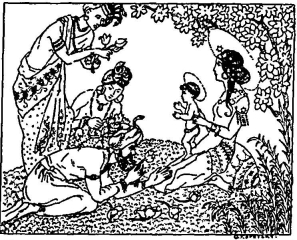 The story told by Matthew’s authors has Magi, not shepherds (the original word here is “magoi,” from which comes our word “magician”) who visit the house in which the divine baby is laid and give him great gifts. (Sorry, no shepherds in this one. Or little drummer boys.)
The story told by Matthew’s authors has Magi, not shepherds (the original word here is “magoi,” from which comes our word “magician”) who visit the house in which the divine baby is laid and give him great gifts. (Sorry, no shepherds in this one. Or little drummer boys.)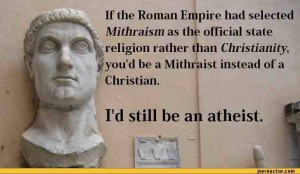 And in the stories of the birth of the Roman/Persian god Mithras, who was sent as “mediator between god and man” and whose worshippers were the Christian’s chief competition, he was visited by “wise men” called Magi at the time of his birth, and presented with … wait for it … gold, frankincense and myrrh.
And in the stories of the birth of the Roman/Persian god Mithras, who was sent as “mediator between god and man” and whose worshippers were the Christian’s chief competition, he was visited by “wise men” called Magi at the time of his birth, and presented with … wait for it … gold, frankincense and myrrh. 






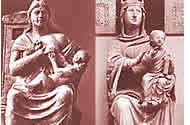 Today, the Myth of the Miraculous Birth:
Today, the Myth of the Miraculous Birth:.jpg) In Buddhist mythology, The Buddha was born of the Virgin Maya, or Mary, after the divine power called “The Holy Ghost” was said to have descended on her in the form of a white elephant! (A little like the session with a white bull enjoyed by Pasiphae, the mother of the Minotaur, but with seemingly more pleasant results.) Like someone else we could mention, it was said of the Buddha“He in mercy left paradise, and came down to earth because he was filled with compassion for the sins and miseries of mankind.” From the time of his birth however, Maya’s womb was sealed up “like a casket in which a relic is placed” and she lived thereafter as a perpetual virgin. So it didn’t all end well for her.
In Buddhist mythology, The Buddha was born of the Virgin Maya, or Mary, after the divine power called “The Holy Ghost” was said to have descended on her in the form of a white elephant! (A little like the session with a white bull enjoyed by Pasiphae, the mother of the Minotaur, but with seemingly more pleasant results.) Like someone else we could mention, it was said of the Buddha“He in mercy left paradise, and came down to earth because he was filled with compassion for the sins and miseries of mankind.” From the time of his birth however, Maya’s womb was sealed up “like a casket in which a relic is placed” and she lived thereafter as a perpetual virgin. So it didn’t all end well for her. In Egypt there was the Saviour Horus, god of vengeance, sky and protection and the second emanation of Ammon, conceived in bizarre fashion out of the virgin Isis and said to be born on December 25; the god Ra, “born from the side of his mother, but was not engendered,” and the sons he himself divinely “engendered”; the god-king Menes likewise.
In Egypt there was the Saviour Horus, god of vengeance, sky and protection and the second emanation of Ammon, conceived in bizarre fashion out of the virgin Isis and said to be born on December 25; the god Ra, “born from the side of his mother, but was not engendered,” and the sons he himself divinely “engendered”; the god-king Menes likewise.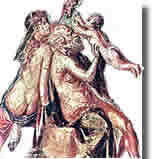 So he was a divine and all-powerful fellow.
So he was a divine and all-powerful fellow.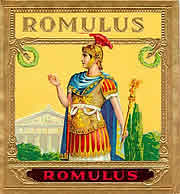 It seems if a Messiah were to be taken at all seriously around these parts, he needed a god for a father and a bit of virgin-birthing to kick his story off.
It seems if a Messiah were to be taken at all seriously around these parts, he needed a god for a father and a bit of virgin-birthing to kick his story off. Alexander the Great was said to have been the son of either Jupiter/Zeus or Ammon (depending on who was telling the story) by the mortal mother Olympias, who was impregnated by a divine snake, all of which no doubt amused his warrior father Philip. His general and partial successor Ptolemy Soter (Ptolemy Saviour) was also said to carry the divine afflatus, as was Cyrus, King of Persia.
Alexander the Great was said to have been the son of either Jupiter/Zeus or Ammon (depending on who was telling the story) by the mortal mother Olympias, who was impregnated by a divine snake, all of which no doubt amused his warrior father Philip. His general and partial successor Ptolemy Soter (Ptolemy Saviour) was also said to carry the divine afflatus, as was Cyrus, King of Persia. 


 Fact is, 'Christmas' itself was originally not even a Christian festival at all. The celebration we now all enjoy was originally the lusty pagan festival to celebrate the winter solstice, the festival that eventually became the Roman
Fact is, 'Christmas' itself was originally not even a Christian festival at all. The celebration we now all enjoy was originally the lusty pagan festival to celebrate the winter solstice, the festival that eventually became the Roman 

 For those who missed it …[the U.S.] 60 Minutes ran not one, but two full segments about the NSA’s data collection and Edward Snowden scandals, told entirely from the NSA’s perspective and with absolutely no critical voices.
For those who missed it …[the U.S.] 60 Minutes ran not one, but two full segments about the NSA’s data collection and Edward Snowden scandals, told entirely from the NSA’s perspective and with absolutely no critical voices.